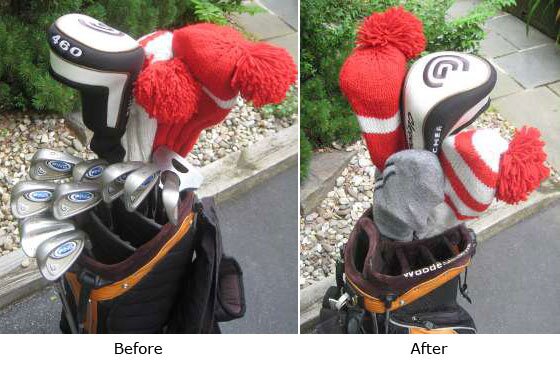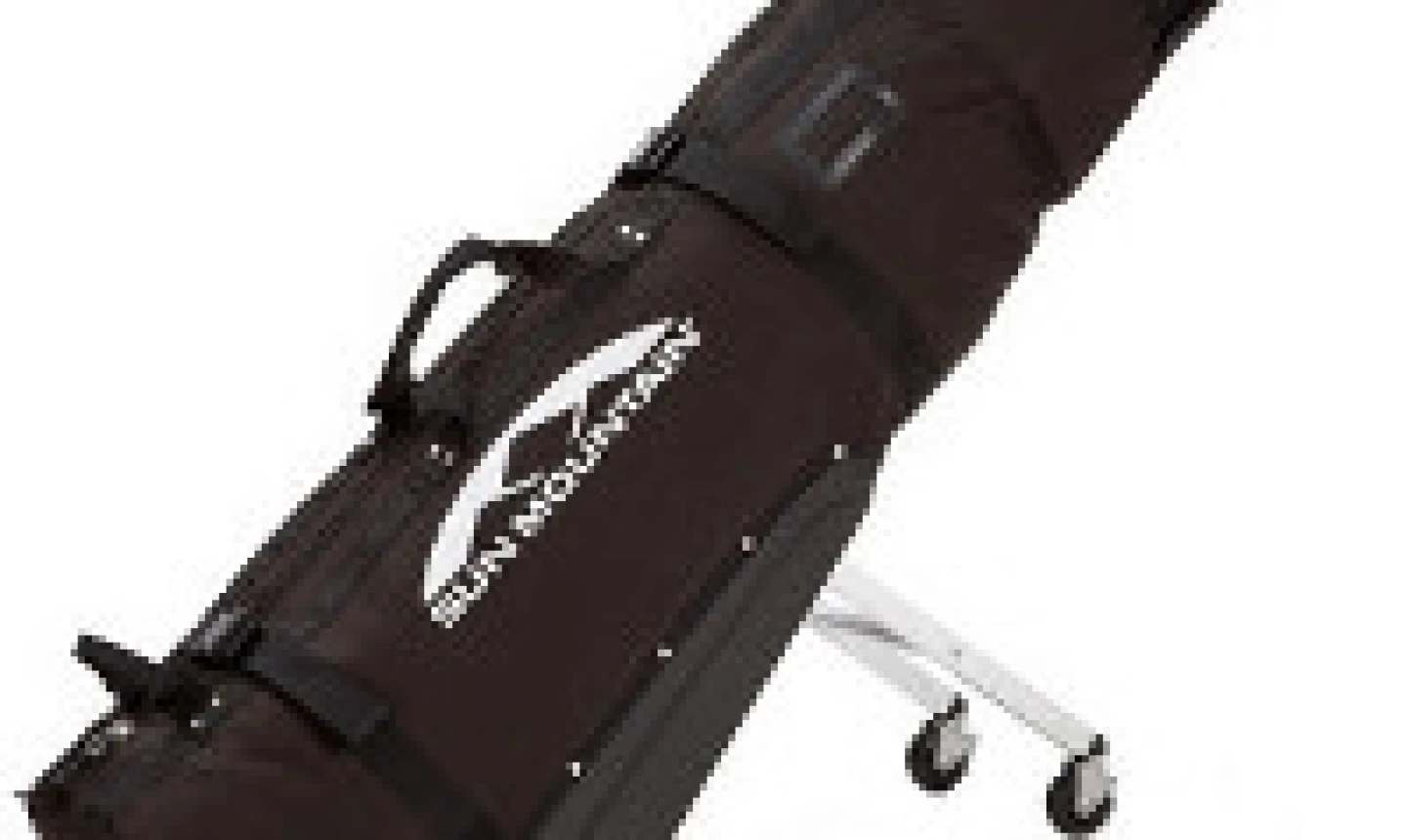
You might think I am obsessive after reading how I pack my golf clubs, but I've flown with them on a lot of golf trips and never once opened my travel bag to find a damaged club (although somewhere there is a baggage handler making his way around a golf course with my driver).
Here are my tips on protective packing, and, of course, I'd love to hear yours, too.
The Theory:
If a club breaks in transit, it usually happens where the clubhead meets the shaft.
Think about it: the rest of the club is protected by the "shell" of the golf bag, but the head sticks out and bears the weight of anything placed on top of it.
So, my entire approach revolves around protecting that point -- where the clubheads meets the shafts.
The Approach
In the old days, I would turn my woods upside down so the heads were inside the bag with the shafts sticking up, but with today's narrower dividers and oversize heads (particularly on drivers) that's usually impossible.
Instead, I go with a "strength in numbers," approach.
For example, a single wooden chopstick is pretty easy to break, right? But bundle 10 chopsticks together and even Dustin Johnson can't break them.
Same idea here: I simply group all the clubs as closely together as possible, preferably will all the shafts in a single section of the bag (see the before and after photos below). It helps to throw a sock over your irons (and putter) to keep them together, and may reduce scratches, too.

Note, too, that I place my tallest club, my driver, in between my other woods/hybrids. The club that sticks up the most is usually going to be the most susceptible to breakage, so I try to insulate it as much as possible.

Once that's done, I throw my rain hood over the whole thing to keep everything in place and as a precaution against rain or leaking engine oil (although if the latter is happening, ruined golf clubs don't seem like such a big deal).
Finally, I put this setup into my golf travel bag.
Once inside, I try to fill up any space above and below the clubheads to further reduce any stress/flex put on them.
In this photo (on my driveway so you could more easily see what I mean), I've placed my shoe bag under the clubheads.

On top, I'll usually put a rolled up golf towel or two.
By the way, there's a product you can buy that largely achieves the same effect as all this.
It's called the Stiff Arm and one of my colleagues never travels without it.
Made by the same company that makes the Club Glove, it's basically a telescoping closet rod with a small frisbee on one end.

Placed down the center of your golf bag and extended up to the top of the inside of your travel bag, it becomes the tallest "club" in your bag and takes the brunt of any weight placed on your gear.
So, am I a freak when it comes to packing my clubs, or do you, too, go to great lengths to ensure they arrive in one piece?
Please share your favorite packing tips or see what others are saying below.
Stay in the Swing with GolfPass!
Get exclusive tips from the pros, in-depth course reviews, the latest gear updates, and more delivered straight to your inbox.






















Hard shell travel cover is the only way to go.
You can drop it, slam it, any which direction
and no damage done to it and for sure none
on the contents. Have used one for years and
never a worry. You can even pack “ extra” things
in it along with a standard cart bag. I believe it comes with a “ coverage protection” of $1,000-$1,500
for contents should anything be damaged inside…like maybe a car crusher meets up with it !
Head down to your local home improvement store and purchase an 8" sonotube. A sonotube is a
thick cardboard tube used for pouring footings, round columns, and piers. With a sharp utility knife it can be cut to fit around your clubs and held in place by the rain cover. Wrap this in your favorite soft sided bag and you are in business. This has worked for me for over 30 years. Inexpensive (<$8), sturdy, simple, and effective.
Used a 5-way 1" PVC connector and schedule 40 PVC pipe instead of paying for an aluminum backbone type device. If you really want to make it strong you could insert a wood dowel down the center of the PVC pipe. Painters tape the shafts of your woods to the PVC pipe and you're good to go.
Home made stiff arm out of a broom stick and a tennis ball
Bubble wrap the irons and then a couple rounds of bubble wrap around the whole lot
Foldable Ping travel bag.
Never a problem!!
I have made a tube out of pvc that slides over all my clubs with a cap on the end. I cut two slits in it and attached it to my rain cover slats with Velcro. Then I place all of it in a padded bag I bought at cabelas works pretty good and it is simple for tsa to put back together correctly
I prefer pretty much the same set up as Craig. I also use the Eagle Creek packing system for luggage, and place a packing cube or 2 with socks, underwear etc around the clubs, followed by the rain cover and tied tight using a bungee cord (which is needed for any trips to the UK or Ireland if one is using the standard antique pull cart). Do not leave home without the Stiff Arm.
Not a fan of the hard case as it is a royal pain upon arrival, especially in Europe where you are unlikely to find a vehicle that will be large enough to accommodate them. There is always the option of leaving the case at the airport left luggage. However, Glasgow airport charges 10 GBP/day ($16/day) for a standard bag and 20 GBP/day ($32/day) for an oversize bag (which they classify a hard golf travel case), making this option an expensive one.
The Trav-A-Lite style bags are a very good option for cart golf, but they are a rotten for those of us that prefer to carry our golf bag.
After recently switching to the Club Glider travel bag I would never use anything else - I really can be manoeuvred with 2 fingers. It is an absolute must for those travelling with golfing spouses and who usually end of managing both golf travel bags.
I have been lucky up to now, with no broken clubs. However, I have had 2 soft travel bags ripped, the second one on its first use. I now use a hard case - so far so good.
I had broken shafts on my 3 and 4 irons on a return trip several years ago with a soft travel bag - went to an SKB hard shell. This worked fine until I started traveling with a couple of engineers who were also golfers. The SKB wouldn't fit in the trunk of many full size rental cars and had to go in the back seat. They started calling it my "sarcophogus"!! So, I bought at Club Glove "Last Bag" three years ago and it has worked fantastic. The uppers have a padded section all the way around the bag and when the outer strap is cinched, it is hard core. I also wrap a soft insulated cooler and a couple towels around the tall clubs which seems to have helped a little more? I routinely do two RT trips a month which amounts to at least 8 different sets of baggage handlers throwing this valuable package around. I know TSA does take every club out of the bag as I've had to reposition the clubs many times to their routine placement. I leave the paper handouts they place in the bag after inspection in the travel bag (must be 50 or 60 of them in there), hoping that they'll not remove all the clubs, but it hasn't seemed to deter their actions!!!!
Similar to Ed, I cut two heavy scale white pvc tubes, just a little longer than my longest club and put them both in my bag along with the clubs. If the end gets banged, the pvc's takes the hit. I also cut white pvc tubes and lay them in the troughs of sliding doors and windows to help prevent illigal entry. They blend in nicely with the vinyl windows and doors.
I tour with a rock band and always bring my clubs for summer tours. I typically ship via FedEx, but have checked them on a number of flights as well. I've had an SKB Hard Case for 7 years and have never had a damaged club. SKB offers to cover damage to your clubs up to $1,500. There's a bit of padding where the club heads go, but I also pack it in with shoes and towels like others in this forum. I keep my clubs in the case when stored in the luggage bay under the tour bus to protect against other roadies' luggage and occasional erratic driving.